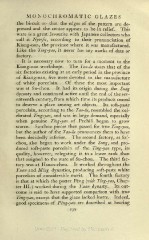Page 321 - Oriental Series Japan and China, Brinkly
P. 321
MONOCHROMATIC GLAZES
the biscuit so that the edges of the pattern are de-
pressed and the centre appears to be in relief. This
ware is a great favourite with Japanese collectors who
call it Nyo-fu, according to their pronunciation of
Kiang-nan, the province where it was manufactured.
Like the Ting-yao, it never has any marks of date or
factory.
It is necessary now to turn for a moment to the
Kiang-nan workshops. The Tao-lu states that of the
six factories existing at an early period in the province
of Kiang-nan, five were devoted to the manufacture
of white porcelain. Of these the most important
was at Su-chou. It had its origin during the Sung
dynasty and continued active until the end of the sev-
enteenth century, from which time its products ceased
to deserve a place among art objects. Its soft-paste
porcelain, according to the Tao-lu, resembled the cel-
ebrated Ting-yao, and was in large demand, especially
when genuine Ting-yao of Pechili began to grow
scarce. Su-chou pieces then passed for true Ting-yao,
but the author of the Tao-lu pronounces them to have
been decidedly inferior. The second factory, at Sz'-
chou, also began to work under the Sung, and pro-
duced soft-paste porcelain of the Ting-yao type, its
quality, however, relegating it to a lower rank than
that assigned to the ware of Su-chou. The third fac-
tory was at Hsuan-chou. It worked throughout the
Tuan and Ming dynasties, producing soft-paste white
porcelain of considerable merit. The fourth factory
is that at which the potter Peng (vide Ting-yao, Chap-
ter III.) worked during the Yuan dynasty. Its out-
come is said to have supported comparison with true
Ting-yao, except that the glaze lacked lustre. Indeed,
good specimens of Peng-yao are described as bearing
259

